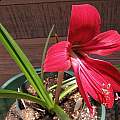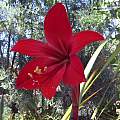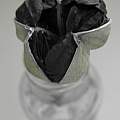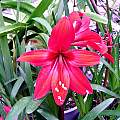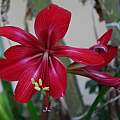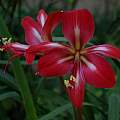×Hippeastrelia is the name used to designate hybrids between Hippeastrum and Sprekelia. The name Hippeaskelia is also used. There is evidence that the hybrid is hardier than its parents see PBS list.
×Hippeastrelia bloomed in late May 2004 from seed started November 1998. The seed came from Bill Dijk who said it was a cross between a dwarf red unnamed Hippeastrum hybrid and Sprekelia formosissima. It did not bloom again until 2010 and has bloomed again in 2011. Height range: 30-90 cm. The first photo is by Mary Sue Ittner. The remaining photos are by Pamela Slate showing the plant blooming in central Arizona in May 2011 and the dehiscing seed capsule. The time between two photos was exactly one month; at its widest point the seed capsule measures 4 cm; the plants are self fertile.
×Hippeastrelia 'Red Star' is a variety I got from Jacques Amand maybe 7 years ago. It blooms reliably every year and tends to bloom after the main group of Hippeastrums. It also seems to be self-fertile, but I've never grown the seed on so I don't know what the F2 generation looks like. (I have donated it to the BX several times.) The color is solid; for some reason my digital camera kept wanting to throw in the yellowy-orange highlights. They're not there in the actual flower. Photo taken May 2004 by Lee Poulsen.
Brent C. Dickerson reported on his Hippesatrelia breeding experience:
A number of years ago, I crossed a pass-along Hippeastrum (which I strongly suspect to be the early hybrid x johnsonii) with Sprekelia formosissima. In due course, the seedlings from this cross bloomed; and me being me, I immediately cross-pollinated two of the seedlings to create an F2 generation. The two plants produced big pods with plenty of seeds. I planted all of the seeds, and it appeared to me that all of the seeds sprouted and grew.
A year or so passed, and they were ready to go from the seed tray into the ground, where I "only" had room for about 50 of the seedlings (there must have been about 80). Being careful to (a) take an equal number of seedlings from each of the two parents; and (b) make a conscious effort to select as far as possible a diversity of seedlings (i.e., not just the strong ones), I planted these out in the open ground.
Over the course of time, two died from unknown causes; but the others have been thriving. Now, about two years later, I am starting to get blossoms from this F2 generation. The very first scape to bloom got itself nibbled by a snail; so instead of showing that, here's the scape from the second plant to bloom.
Left: First generation (F1) hybrid. Right: Second generation (F2).
As the pod-parent of the F1 generation was the Hippeastrum, it's interesting to note that the progeny very much more resemble the pollen parent, the Sprekelia. All leaves of all plants in both generations are shiny and narrow like those of Sprek, and the flowers show most decidedly the influence of the Sprek not only in their form but also in the fact that, at least so far, they produce only two blossoms in each scape. I call this cross Sprekeastrum.
The various blossoms I've gotten from the various individuals in the F1 generation are all just about the same. Pleasant, but only moderately inspiring!
I'm looking for variation here in F2; but these two first ones in F2 to bloom look just like each other. Of the two blossoms on each scape, there's a slight tendency for the first one to bloom to be held more horizontally, and to be more zygomorphic (like a Sprek), and for the second blossom on the scape to be held somewhat more vertically (like neither Hip nor Sprek!), and to be more actinomorphic. Odd!
What I find interesting is that the Sprekelia type of foliage continues not only dominant in each generation of the cross--not only dominant, but completely excluding foliage of the Hippeastrum type, even though the pod-parent in the original cross was Hipp. As far as I can tell from pictures of various Hippeastreleas, this is also true for the similar crosses which others have made. I wonder in what generation some Hippeastrum-type foliage will finally show up...?
